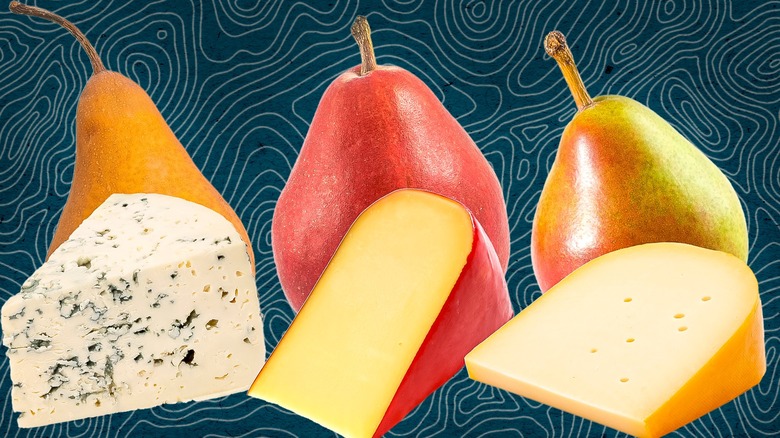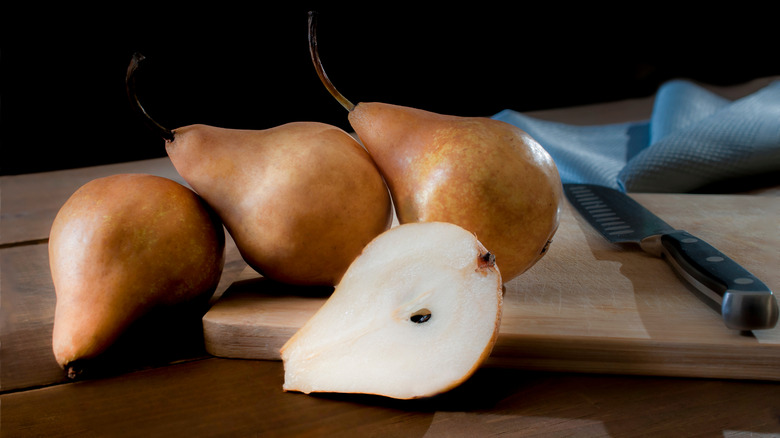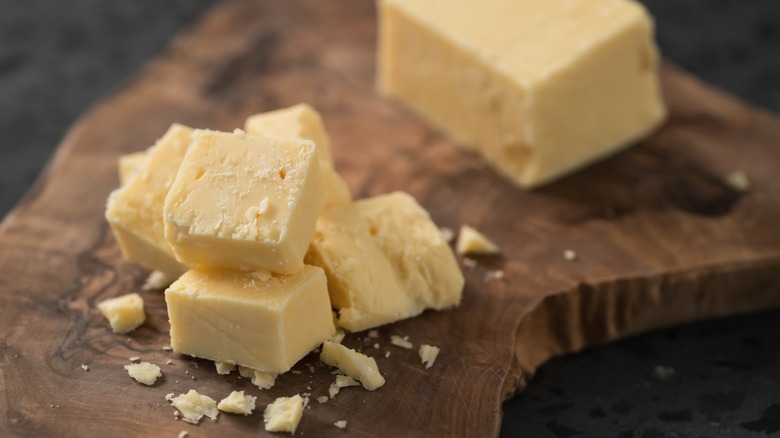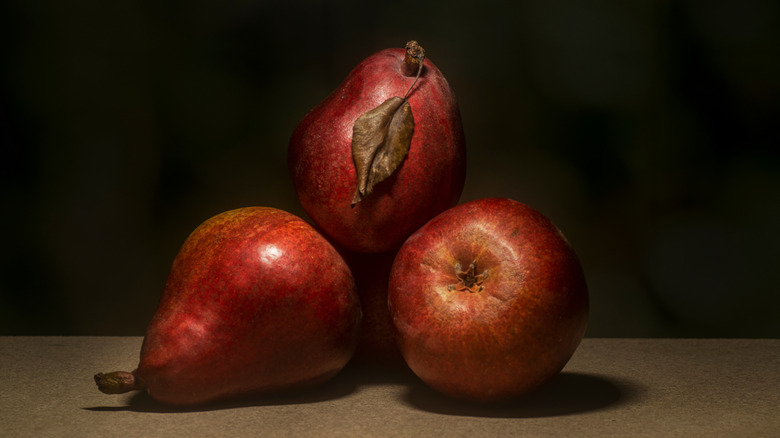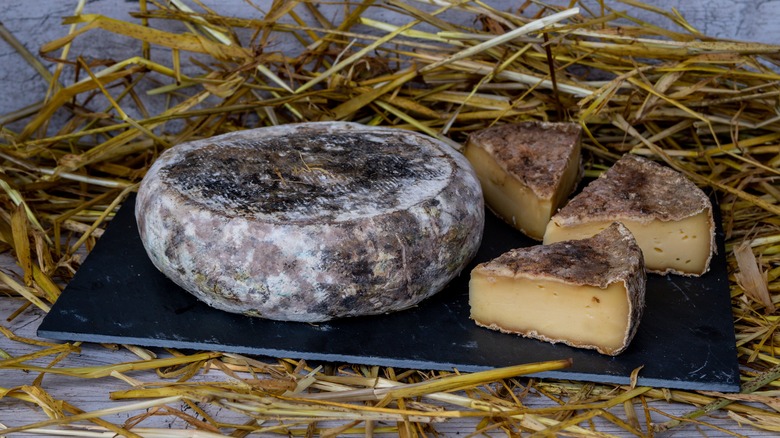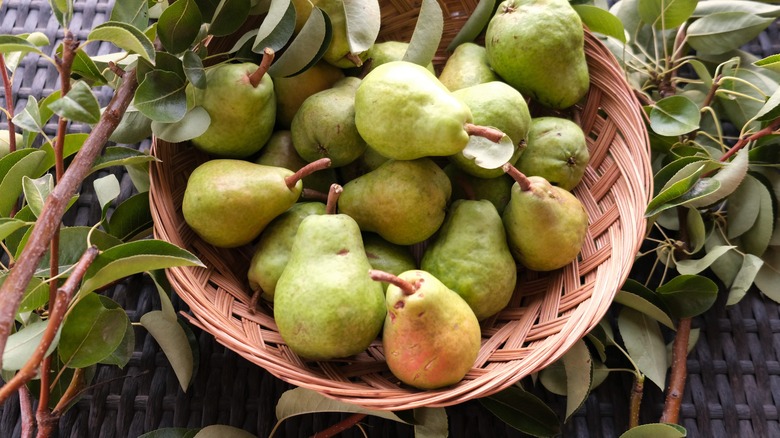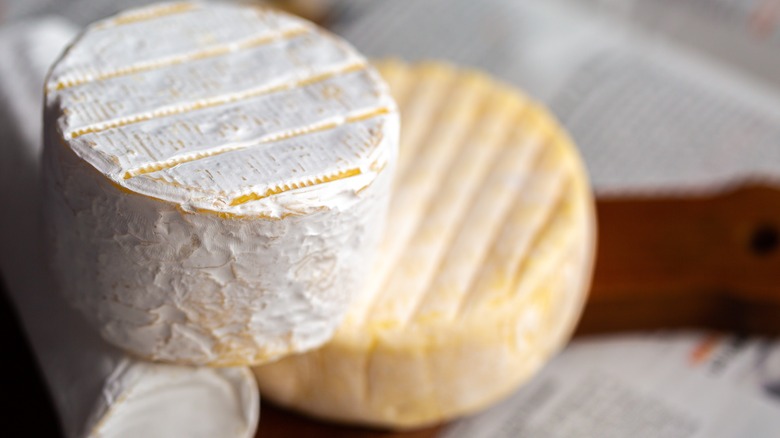6 Delicious Pear And Cheese Pairings - Exclusive
Ask any cheesemonger and they'll likely tell you the question they're asked most often is which cheeses pair best with which fruits. While it's hard to prove this combination has historical significance beyond the aesthetic (how many bunches of grapes have been painted next to a stinking wedge of cheese and a brute bottle of wine?), anecdotally, the sweet fleshiness of ripe fruit just always seems to work alongside a hunk of the good stuff.
When it comes to fruit and cheese pairings, a good place to start is with the pear. Understated and elegant, its firm flesh holds up nicely to both hard and soft cheeses, and it's equally diverse in flavor, aroma, and appearance as an apple. However, unlike apples, whose highly appealing texture and flavor are often the product of genetic modification, many of the common pear varieties you'll find in supermarkets have centuries-old legacies without calling themselves "heirlooms."
To get a sense of which pears taste best with the limitless possibilities of cheese, we consulted Tenaya Darlington, a Philadelphia-based cheese educator and author of Madame Fromage's Adventures in Cheese. The size of the fruit, along with its texture, flavor, and color, all influenced her selections.
Bosc and Roquefort
Bosc pears sport a stout bottom, tapered neck, and a matte, khaki-color skin that leaves a trace of bitterness on your tongue. Three varieties of Bosc are known to be documented: buttery Beurré Bosc, the gourd-shaped Calabasse, and the Beurré d'Appremont, named after a comune in the Grand Est region of northern France where this varietal originates. The Bosc pear gets its namesake from M. Bosc, a former director of the Paris Botanical Garden rumored to have grown the species from seed in early 19th century Belgium.
Darlington considers Bosc to be one of the sweetest varieties of pears. To complement its high sugar content, she suggests pairing Bosc with a cheese that's salient and funky, like a hunk of French Roquefort.
For Italians, the King (or Queen) of cheese is Parmigiano Reggiano — salty, umami, and unequivocally the perfect topping for any Italian pasta dish. But for the French, that cheese is Roquefort, the stinky yet refined cousin of blue cheese. You can distinguish Roquefort from other cheeses that contain edible molds, like Gorgonzola and Stilton, by its blue-green veins. Roquefort was the first cheeses to ever be protected under France's strict Appellation d'Origine Contrôlée (AOC) designation. As such, the cheese must be made with sheep's milk from the Lacaune breed and inoculated with penicillium roqueforti spores. The cheese continues to be aged in the same caves where this strain of mold was first discovered.
Seckel and Cheddar
With their petite stature, Seckel pears look almost too precious to eat. But these little guys are not to be overlooked: The chubby fruits are honey-sweet and exceptionally crunchy, even when ripe, like that of an Asian pear. The pint-sized pear is perfect for snacking or on-the-go enjoyment. "Pack a crisp little Seckel in your lunch," says Darlington. Slicing and deseeding the miniature seckel takes some patience and finagling, so the best way to enjoy these is straight out of the palm of your hand, making them an easy, elegant addition to a cheese board. Just toss a few on; no prep required.
No one truly knows how the pear arrived stateside. The fruit closely resembled the delicate Rousselet de Reims and was likely brought to the U.S. as seed — either inadvertently or intentionally — by German immigrants. Darlington thinks these little pears play nicely with an unassuming but sophisticated cheese that chunks easily for convenience — like cheddar.
By definition, cheddar refers to a family of cheeses made using the cheddaring technique, a traditional cheesemaking process in the United Kingdom. Curds are drained of whey, stacked, and cut into neat blocks ready for aging. For pairing with Seckels, think beyond the orange block and opt for something crumbly and expressive, like a bandaged English. For a creamier, funkier alternative altogether, Darlington assures us that the Seckel's snappiness is also a good fit for a soft cheese such as Camembert.
Red Anjou and Gouda
A well-put-together cheese board takes advantage of both flavor and aesthetics. "With its bright skin, this is a good pear for adding color to a board," says Darlington of the Red Anjou, a pear who gets its color from a rare genetic mutation.
The Red Anjou pear has no storied legacy. It was never meant to be at all. These pears were birthed from the "bud sports" found on the green D'Anjou pear trees. Bud sports are a natural transformation that occurs when some tree branches decide to go off script and sprout buds that vary from those of their neighbors. This anomaly doesn't usually produce fruit fit for sale, but the bud sports we now call Red Anjou were found to be viable, propagated further, and later, commercialized.
Darlington likes to take advantage of Red Anjou's color by pairing it with equally bold-hued cheese. "I'd tuck it next to a hunk of golden Gouda, like Beemster XO or L'Amuse Gouda, along with a handful of candied pecans," she tells us. Gouda, a Dutch cheese dating back to the early 12th century Holland, can be made from any pasteurized or raw milk. Depending on the age, the texture and flavor of Gouda ranges from semi-soft and buttery to firm and butterscotch. For older goudas, don't bother slicing: Just stick the tip of a sharp knife into the wedge and pull backward on the handle until the cheese crumbles into organic chunks.
Concorde and Tomme Brûlée
The continental Concorde looks as though it were rendered in a French Renaissance painting. This pear has a long neck that comes to a point and green skin that blushes at its base, as if bashful of the sun. Its juicy flesh stays succulent, even when firm. These pretty pears are harvested in late Fall, with their season finishing shortly before the holidays. Concordes oxidize slowly after being sliced, making them the perfect addition to a cheeseboard.
No need to limit yourself to serving these raw: The dense flesh of Concorde holds its shape when subjected to the high temperatures of roasting, baking, and even searing. "There's a gentle vanilla flavor to these juicy pears," says Darlington. For that reason, she recommends pairing Concordes with an aged sheep's milk cheese that runs on the sweeter side, like a Tomme Brûlée.
Torched in the same fashion as the iconic French dessert, the gothic Tomme Brûlée sports a carbonized rind that gives this cheese a lightly smoked quality without wood fire's pungency. Underneath its charred rind, you'll find the paste to be pleasantly silky, yet firm; with a toasty, funky aroma — like a cross between browned butter, warm nuts, and game meat — that complements a Concorde's vanillin qualities. "Think of this as a "creme brulee" combination in cheese-and-pear form," says Darlington.
Bartlett and Taleggio
The Barlett, also called the Williams Pear, is a stocky, russett variety with juicy, medium-firm flesh. The flavor is approachable, with enough acidity to balance out its candy sweetness. (Think: Juicy Pear jelly bean). It's one of the oldest European varieties, originating in England when tree cuttings from a schoolmaster in the Royal County of Berkshire were sold to a horticulturist by the name of Williams. The pear eventually made its way to the United States, where it found a foothold in the US market when the owner of a tree nursery, a man by the name of Barlett, began selling it as his own.
There's nothing wrong with simplicity, but Darlington recommends experimenting with them beyond raw, like in a pear jam. "A chutney made from Bartlett pears would be fantastic," she says. As for cheese, try something a bit more striking: "I'd serve a Bartlett alongside a funky washed-rind cheese, like Taleggio."
Talegio is named after a valley in the historic Italian province of Bergamo. This soft imported cheese is made from local cow's milk and matures in as little as fifty days. With its coarse red rind and oozing interior, Taleggio is reminiscent of a Brie or a camembert. It's a member of the stracchino family: Cow cheeses with blood ties from their milky flavor, rindless exterior, and oozing paste. It is said that the hardworking Alpine cows who produce these cheeses were tired, or stracco, coming back from pasture, hence the name stracchino.
Comice and Triple Crème
The green-red Doyenné Du Comice pear — the Doyenne of the pear world — looks as if it's dressed for the holidays. It's no wonder that you'll find this pear stuffed into gift baskets and sold in December, earning it the title of "Christmas Pear." Like most other European varietals, the Comice was propagated in the mid-19th century. You'll want to treat these pears gingerly, as their skin is thin and fragile, but keep in mind that discoloration on the peel doesn't necessarily indicate bruised flesh.
"A buttery Comice, usually sold right around the holidays, is a great match for a triple crème," says Darlington. When shopping, she recommends keeping an eye out for St. Stephen from New York State, or any number of sumptuous Brie-style cheeses that meet the 75% butterfat content minimum of triple crème. Though often conflated with Brie, Triple Crèmes, like the stracchino cheese of Italy, are a broad family of cheeses characterized by their bloomy rinds and the high proportion of cream to milk.
Whereas triple crème is a type of cheese, Brie is a style; both Brie de Meaux and Brie de Melun are protected by the AOC designations. Most brie-style cheese are double cream, with 60–75% butterfat, which meets the range of a double cream cheese. To produce a triple crème brie, cheesemakers must add a third more cream to the paste for an exceptionally rich cheese that's more buttery than butter itself.
